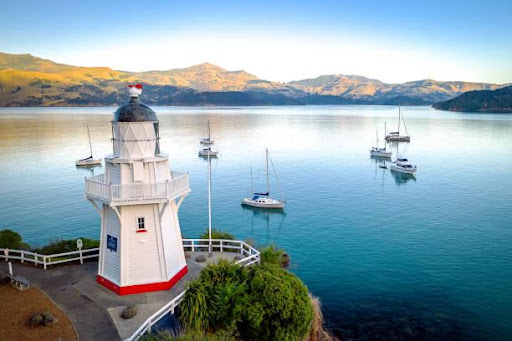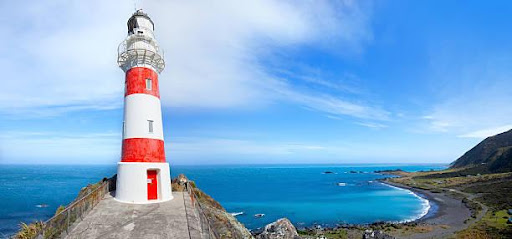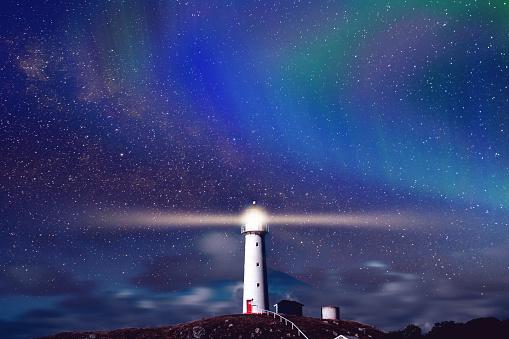Must See Lighthouses in New Zealand
From Castle point at the tip of the North Island to Waipapa in the Deep South, these stunning lighthouses adorn New Zealand’s coastline. The coastline of New Zealand is dotted with over 100 lighthouses and mini lighthouses.
Lighthouses fascinate people all around the world. As a country that is completely surrounded by water, it’s not surprising that the shores of New Zealand are scattered with lighthouses. These lighthouses are interesting sites that are rich in history and aid maritime navigation around New Zealand’s coastline.
Lighthouses provide a warning to mariners about dangerous shallows and perilous rocky coasts. While the practicality of lighthouses makes them an essential feature for coastal regions, they are beautiful structures in their own right and add something appealing to the scenery. They add a touch of old-fashioned romanticism to the location that gives aesthetic pleasure to the visitors.
The rugged and bleak ambience of the lighthouse makes it unique and acts as a beacon of hope saving countless lives over the years. These intriguing structures can be considered as a reminder of New Zealand’s maritime history, as combined they overlook around 120 shipwreck sites. Majority of these historic buildings have been restored and are made accessible to visitors but only 23 are still active which are fully automated and monitored from a central control room in Wellington. Visiting some of these isolated lighthouses must be on the bucket list of every travel enthusiast. We’ve picked some stunning lighthouses to discover around the country so follow the beacon to find some of the oldest, magnificent lighthouses in the country.
Castle Point Lighthouse, Wairarapa
Castle Point Lighthouse located near the village of Castlepoint on the Wairarapa coast in the north of Wellington was one the last manned lights to be established in New Zealand. The Castle point area was a dangerous place for ships and had a number of wrecks, which led to the establishment of navigation lights on the Wairarapa coast. Hence, Castlepoint reef was chosen as the site of the last watched lighthouses to be built in New Zealand. Regarded as one of North Island’s tallest lighthouses, Castle Point was first lit in 1913 and is one of the only two remaining beam lighthouses in New Zealand. The lighthouse stands on a rocky promontory with magnificent views and the long quiet beach also offers beautiful sunrises. The lighthouse extends out on headland but even more interesting is Castle Rock, a steep section of rock that the visitors can climb in order to get a bird’s eye view looking down on the lighthouse. The lighthouse was named by Captain Cook after this main rocky promontory which looked like a castle.
For the adventure enthusiasts, there is a great return walk that will take you down a boardwalk and over a reef where you can look for fossil shells. The area is well known for seals so it is advised to keep your distance. You may also spot whales, humpbacks, dolphins in the sea. On the other side of the lighthouse lies the beach of Castlepoint with its long sandy bay which offers a beautiful view of the lighthouse. The beach, walking trails galore, and Castlepoint Lighthouse combine to create one of the most stunning and rugged coastal landscapes in North Island, one that you must not miss out on.
Waipapa Point Lighthouse, Catlins
Waipapa Point Lighthouse, located at the southern end of the Catlins region near Fortrose, was constructed at the scene of New Zealand’s worst civilian shipwrecks in which 131 passengers lost their lives. The passenger steamer Tararua was wrecked on rocky reefs off of Waipapa point during its regular trips in 1881 which caused the drowning of these 131 people. The investigation regarding the loss of the Tararu led to the Court of Inquiry recommending a light to be erected at the point of wreck. The Waipapa Point Lighthouse that stands as a poignant reminder of the disaster became operational in 1884 and the light was later replaced by an LED beacon installed externally on the balcony of the lighthouse. This light is monitored from Maritime New Zealand’s Wellington office.
Many of the bodies recovered from the wreck are buried in a small plot of land called the Tararua Acre situated near the tower and visitors can pay their respects to those who lost their lives at this cemetery as well as know more about the history of the lighthouse. Apart from the lighthouse, sweeping golden beaches and snoozing sea lions serve as the main attraction for the visitors. At the base of the lighthouse, sea lions and fur seals can be seen, and it is recommended to be cautious as the sea lions put on a show fighting with each other. It is also a great spot for stargazing and catching a glimpse of the Aurora Australis, also known as Southern Lights, due to the low levels of light pollution. Visit the southwest corner of the Catlins to witness scenic sand dunes, rugged coastline, sea mammals and a historic lighthouse.
READ MORE:
One of the most beautiful mountainous parks in New Zealand is best visited from November to March. This National Park feeds the souls of Nature lovers with the dense and native forests, glacial and river valleys, and towering snow-capped peaks. Read more at Tourist Guide to Mt Aspiring National Park.
Nugget Point Lighthouse, Catlins
 Nugget Point Lighthouse
Nugget Point Lighthouse
Nugget Point Lighthouse, located on the northern part of The Catlins coast, is an iconic panoramic platform and one of the most spectacular lighthouses of the country. Also referred to as the Tokata Lighthouse, it is situated in South Island, near the mouth of Clutha River with several small islands and reefs situated close to it. Built in 1869 it is one of New Zealand’s oldest lighthouses that gives visitors a view of the rugged sea. Its location in the remote Catlins area perched above the famous ‘Nugget rocks’ is one-of-a-kind. From the car park area, visitors can commence their walk to the Nugget Point Lighthouse with wave-eroded rocks sticking out of the water at the end of the path. These ‘nuggets’ of rocks that split the sea in half lead to Captain Cook, the British explorer and naval captain, naming this iconic Catlins lighthouse as ‘Nugget Point’ as the rocks looked like pieces of gold. The well maintained walking tracks makes it an enjoyable outing for all ages.
The light that began operating in 1870, now replaced with a LED beacon mounted externally, is monitored from Maritime New Zealand’s Wellington office. Witnessing the sunrise over the ocean at Nugget Point is a heavenly and unrivaled experience in New Zealand. During the day, the visitors can enjoy the coastal view from the lighthouse and spot a variety of wild animals such as Royal Spoonbills, sea lions, elephant seals, Shags and other sea birds, which provide entertainment to the visitors. A colony of New Zealand fur seals frolicking on the rocks at sea level and below the lighthouse is one of the main tourist attractions. Yellow eyed penguins can be spotted at dusk on the road to Nugget Point at Roaring Bay as they move from the sea to their nesting places in coastal vegetation. If you wish to witness amazing wildlife on a spectacular spur where the ocean meets the sky, head towards the photogenic Nugget Point Lighthouse.
Cape Palliser Lighthouse, Wairarapa
 Cape Palliser Lighthouse
Cape Palliser Lighthouse
Cape Palliser Lighthouse, one of the most iconic lighthouses in New Zealand that marks the southernmost point of the North Island, is located on the south eastern side of the Wairarapa coast. The rugged coast and notorious Cook Strait gales contributed to many shipwrecks and the lighthouse now guards the site of over 20 ships’ resting place. It is just an hour’s drive from Martinborough, Wellington with unforgettable sea views along the way that exhibit the power of the ocean. The sounds of the wind and foaming seas blend together in a raw orchestrated duet that sums up this stretch of coast.
The lighthouse is fully accessible to those that are fit enough to climb over 250 steps to this traditional red and white striped beauty, which stands out from the hills behind it. It’s quite a difficult climb up the wooden staircase to this 18m structure that still stands in the place where it first shone a light in 1897.The trail leading to the lighthouse is primarily used for hiking and walking, however, dogs can also use this trail provided they are kept on leash. A trip to Cape Palliser from Wellington is worth the drive as you can witness North Island’s largest fur seal colony with seals frolicking in the sun. A small fishing settlement of Ngawi is situated near Cape Palliser where the visitors can stop and look at the line of fishing craft above the beach. Now you know where to head to for witnessing seals, experiencing stunning walks and the spiffiest lighthouse in the country.
READ MORE:
If you ever happen to visit the country of New Zealand, do not forget to take some time out and visit some of New Zealand's most celebrated art museums. We assure you it will be an experience of a lifetime and it will only broaden your knowledge in terms of the varied meanings of art.
Cape Egmont Lighthouse, Taranaki
 Cape Egmont Lighthouse
Cape Egmont Lighthouse
Cape Egmont Lighthouse, situated at the western-most point of the Taranaki coast, about 50 kilometers south west of New Plymouth has been shining its light since 1881. This nomadic lighthouse was assembled on Mana Island, near Cook Strait in 1865. However, the light being confused with the Pencarrow light contributed to two 1870s ship accidents so it was dismantled and transported to Cape Egmont headland and rebuilt at its current site in 1877.The drive from New Plymouth along the coast reveals stunning views of the Tasman Sea and the rugged coastline of New Zealand’s North Island. It is built on a gentle rise at a short distance from the beach. The splendid landscape around the lighthouse is characterized by grassy hillocks and lahar mounds caused by volcanic explosions in the past. Visitors can take advantage of excellent photo opportunities that are available from almost any angle in this secluded coastal location. However, the presence of the stunning Mount Taranaki in the background makes it difficult to tell what people are focusing on while taking pictures of Cape Egmont Lighthouse. Cape Egmont Lighthouse was recognized as a heritage place and must be added to your list of must-visit places in New Zealand.
Pencarrow Head Lighthouse, Wellington
New Zealand’s first permanent lighthouse, Pencarrow Lighthouse, is situated on a wind-swept promontory high above the Wellington Harbour entrance. This historically remarkable lighthouse tells stories of early settlement, shipwreck, and a strong woman. It was run by its first and only female lighthouse keeper, Mary Jane Bennett who operated the light from her cottage at Pencarrow Head. Her eventful life at this remote place is commemorated on a storyboard at the lighthouse. The rugged stretch of the rocky coastline that leads to Pencarrow Head battered by rough waters, offers spectacular harbor scenery complete with whirling birds and rocky beaches. You can witness native seabirds and plant life thriving on the exposed coastline, along with indigenous waterfowl, eels and freshwater fish in their natural habitat at Lake Kohangatera and Lake Kohangapiripiri.
After walking approximately 8 km on an unpaved flat track, a short, sharp climb, the visitors can witness this important landmark in all its glory, looking as elegant and romantic as a lighthouse should be. However, it has a rugged environment and the weather can be wild and highly changeable with a strong wind, so it is advised to check the weather conditions before your visit. Even though the lighthouse is no longer in service, it stands as a landmark of Wellington and a pilgrimage to Pencarrow Lighthouse would make a memorable day trip for those in need of a reminder of the power of the sea.
READ MORE:
The Maori call the Island – Raikura which translates to the land of glowing skies and the name comes from the regular visibility of the Aurora Australis – Southern Lights from the Island. The Stewart Island is home to a myriad of birds and the best place to go birdwatching.
New Zealand Visa Application Form now allows visitors from all nationalities to obtain New Zealand eTA (NZETA) by email without visiting New Zealand Embassy. Government of New Zealand now officially recommends New Zealand Visa or New Zealand ETA online rather than sending paper documents. The only requirement is to have a Debit or Credit Card and email id. You do not need to send your passport for Visa stamping. If you are arriving to New Zealand by the Cruise Ship route, you should check the New Zealand ETA eligibility conditions for Cruise Ship arrival to New Zealand.
